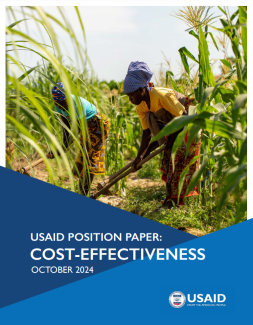USAID can increase its impact on key outcomes, for every dollar of taxpayer money spent, through the use and generation of cost-effectiveness evidence in program design and implementation. Shifting from less to more cost-effective interventions allows the same budget to generate deeper impact for a given population and/or reach more people by expanding the scale of critical development or humanitarian assistance.
Building on two decades of growth in impact evaluations, particularly randomized evaluations, of development and humanitarian programs, this Position Paper underscores the importance of, and the ability for, greater use of cost-effectiveness evidence in USAID programming.
This Position Paper lays out USAID’s commitment to cost-effectiveness and outlines five principles:
- Cost-effectiveness is about impact per dollar
- Assessing cost-effectiveness is inherently comparative
- Context matters
- Use existing cost-effectiveness evidence, or produce it (cost-effectively)
- Cost-effectiveness is not the only thing that matters
Guided by these five principles, USAID will continue to prioritize taking action where evidence exists and conducting impact evaluations with rigorous cost measurement where it does not, committing to a culture of continuous learning to deliver more impact per dollar. Such thought leadership not only enhances USAID’s stewardship of taxpayer’s resources, but drives broader improvements for bilateral and multilateral partners and thus the communities that USAID supports around the world.
To learn more about the Cost-Effectiveness Position Paper, please contact the Office of the Chief Economist at oce@usaid.gov.

